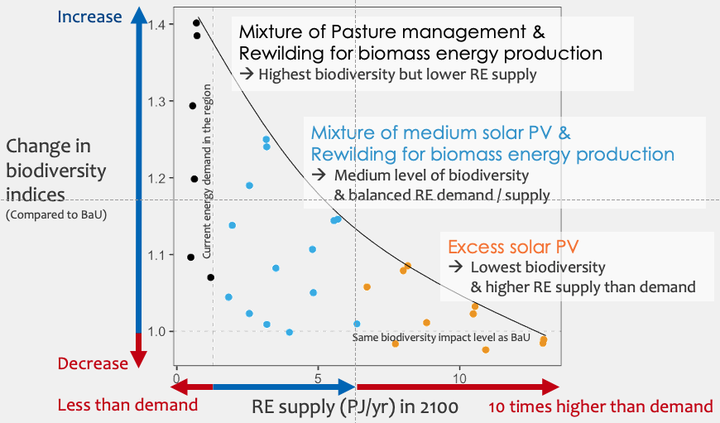Scenario Analysis of Renewable Energy–Biodiversity Nexuses Using a Forest Landscape Model
 Graphical Summary
Graphical Summary
Abstract
The introduction of renewable energy (RE) in harmony with nature is essential for building a sustainable society. However, the poorly designed introduction of RE can cause conflicts between energy production and biodiversity conservation. This study conducted a scenario analysis to evaluate potential conflicts in the nexuses between energy and biodiversity for a case study area, the Bekambeushi River watershed located in northeastern Japan. The increasing rate of pastureland abandonment resulting from a decreasing farmer population is a source of great uncertainty in this area. Two alternative sources of RE were selected to utilize these abandoned pasturelands, each taking a contrasting approach to meet targets stipulated by regional energy plans, thereby implying different ecological consequences at the landscape level. Thirty-one RE introduction cases were simulated, comprising a range of pastureland abandonment expansion speeds and ratios of solar photovoltaic (PV) plant installation to biomass energy use. These were superimposed using two IPCC representative concentration pathway (RCP) scenarios, 2.6 and 8.5, resulting in 62 cases that were summarized as three scenarios based on the RE supply– demand balance and the ecological impacts. The LANDIS-II model was used to simulate these scenarios from 2016 to 2100. The results indicate that both the rate of pastureland abandonment and the ratio of the two RE sources had a large impact on changes in tree species diversity and the habitat suitability of raptorial birds. Abandoned pastureland converted to tree biomass energy production shifted to pioneer species-dominated forest. The plant species composition of transitional forests varied between the climate scenarios. The higher temperature of the RCP 8.5 scenario toward 2100 prevented the establishment of Betula platyphylla and altered tree species diversity and the habitat suitability of Ketupa blakistoni blakistoni. Biomass energy utilization produced less energy than the demand but increased the three ecological indicators. Solar PV systems provided more energy than the regional demand, but the three ecological indicators decreased. However, an appropriate mixture of the two RE sources satisfied the regional energy demand and maintained ecological conditions. Our results suggest that land– energy planning should consider energy– biodiversity nexuses to a strike balance between decarbonization and biodiversity conservation.